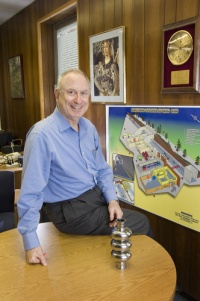Difference between revisions of "User:IlanBenZvi"
(created user page) |
|||
| (One intermediate revision by the same user not shown) | |||
| Line 1: | Line 1: | ||
[[Image:IlanBen-Zvi.jpg|thumb|200px|right|Ilan Ben-Zvi]] | [[Image:IlanBen-Zvi.jpg|thumb|200px|right|Ilan Ben-Zvi]] | ||
| − | Ilan Ben-Zvi | + | Ilan Ben-Zvi is a Senior Scientist with tenure, Associate Chair for Accelerator R&D at BNL’s Collider-Accelerator Department and head of the Accelerator R&D Division, and Brookhaven Professor of Physics at Stony Brook University. He has been at Brookhaven since 1988. Ben-Zvi served as the Director of the Brookhaven Accelerator Test Facility for 15 years, where he worked on advanced accelerator concepts, free-electron lasers and high-brightness laser-photocathode RF guns. He is past chair the BNL Council. |
| − | Ben-Zvi | + | Ben-Zvi earned B.Sc. in mathematics and Physics, 1965, from the Hebrew University of Jerusalem, Ph.D. in Nuclear Physics, 1970, from the Weizmann Institute of science. Research Associate, Stanford University 1970-1975, Senior Scientist Weizmann Institute 1975-1980, Visiting Associate Professor Stony Brook University 1980-1982, Senior Research Fellow, Weizmann Institute 1983-1988, Visiting Professor Stony Brook University 1988-1990. |
| − | Ben- | + | Ben-Zvi’s current research interests are RF superconductivity, electron cooling, high-brightness, high-power electron sources, Energy Recovery Linacs and high-power Free Electron Lasers, areas in which he acquired extensive experience over 40 years. He led the development of superconducting accelerator elements such as an ERL 703.75 MHz 5-cell cavity, photocathode injector based on SRF technology, SRF storage cavity for RHIC and compact crab cavity for the LHC luminosity upgrade. His research team is constructing the highest current ERL, aiming at 0.3 ampere. He also initiated and led the R&D on the diamond-amplified photocathode and other high-current photocathodes. |
| − | + | Ben-Zvi was honored extensively by his peers: Elected in 1994 as a Fellow of the American Physical Society, elected in 2007 as Fellow of the American Association for the Advancement of Science and in 2009 as a Fellow of the IEEE. He received the 1999 IEEE/NPSS Particle Accelerator Science and Technology Award, the 2001 BNL Science and Technology Award, the 2007 Free-Electron Laser Prize and the 2008 IEEE/NPSS Merit Award. | |
| − | + | He served leading roles in various meetings and panels, including the HEPAP Subpanel on Advanced Accelerator R&D (AKA the Marx Panel) and was selected to serve on the National Academies Committee for the Scientific Assessment of Free-Electron Laser Technology for Naval Applications. His public service roles include past Secretary-Treasurer of APS/DPB, past Chair of the IEEE/NPSS Particle Accelerator Science and Technology Committee and service on the editorial board of PRST-AB. Currently he is a Division Associate Editor of Physics Review Letters, member of HEPAP and ACOT. He initiated the joint accelerator conferences web site now known as JACoW. He is the author or co-author of over five hundred publications. | |
| − | + | ||
| − | + | ||
Latest revision as of 14:52, 14 December 2013
Ilan Ben-Zvi is a Senior Scientist with tenure, Associate Chair for Accelerator R&D at BNL’s Collider-Accelerator Department and head of the Accelerator R&D Division, and Brookhaven Professor of Physics at Stony Brook University. He has been at Brookhaven since 1988. Ben-Zvi served as the Director of the Brookhaven Accelerator Test Facility for 15 years, where he worked on advanced accelerator concepts, free-electron lasers and high-brightness laser-photocathode RF guns. He is past chair the BNL Council.
Ben-Zvi earned B.Sc. in mathematics and Physics, 1965, from the Hebrew University of Jerusalem, Ph.D. in Nuclear Physics, 1970, from the Weizmann Institute of science. Research Associate, Stanford University 1970-1975, Senior Scientist Weizmann Institute 1975-1980, Visiting Associate Professor Stony Brook University 1980-1982, Senior Research Fellow, Weizmann Institute 1983-1988, Visiting Professor Stony Brook University 1988-1990.
Ben-Zvi’s current research interests are RF superconductivity, electron cooling, high-brightness, high-power electron sources, Energy Recovery Linacs and high-power Free Electron Lasers, areas in which he acquired extensive experience over 40 years. He led the development of superconducting accelerator elements such as an ERL 703.75 MHz 5-cell cavity, photocathode injector based on SRF technology, SRF storage cavity for RHIC and compact crab cavity for the LHC luminosity upgrade. His research team is constructing the highest current ERL, aiming at 0.3 ampere. He also initiated and led the R&D on the diamond-amplified photocathode and other high-current photocathodes.
Ben-Zvi was honored extensively by his peers: Elected in 1994 as a Fellow of the American Physical Society, elected in 2007 as Fellow of the American Association for the Advancement of Science and in 2009 as a Fellow of the IEEE. He received the 1999 IEEE/NPSS Particle Accelerator Science and Technology Award, the 2001 BNL Science and Technology Award, the 2007 Free-Electron Laser Prize and the 2008 IEEE/NPSS Merit Award.
He served leading roles in various meetings and panels, including the HEPAP Subpanel on Advanced Accelerator R&D (AKA the Marx Panel) and was selected to serve on the National Academies Committee for the Scientific Assessment of Free-Electron Laser Technology for Naval Applications. His public service roles include past Secretary-Treasurer of APS/DPB, past Chair of the IEEE/NPSS Particle Accelerator Science and Technology Committee and service on the editorial board of PRST-AB. Currently he is a Division Associate Editor of Physics Review Letters, member of HEPAP and ACOT. He initiated the joint accelerator conferences web site now known as JACoW. He is the author or co-author of over five hundred publications.
